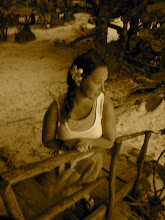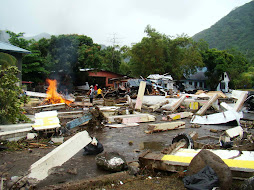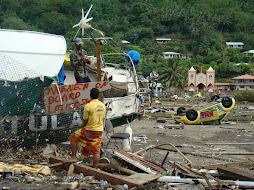Tsunami Story:
Maxwell Dunne: World Teach Volunteer & Samoana High School Teacher
Tuesday morning 9/29/09 at 6:48 am I was walking to the bus stop from my house at Coconut Point in Nu’uuli. I am a teacher at Samoana High School in the village of Utulei and was on my way to work. As I was walking down the road I thought I was having a muscle spasm or something in my legs since I felt a tremendous shaking. I noticed everyone was coming out of their houses and one of my friends, Jeremy, was among them. At that moment I realized I was experiencing my first earthquake. Coming from Chicago, I had never felt the earth move like that before and I was a bit anxious. We talked a minute and as I was walking away I jokingly said, “hey, isn’t this when the big tidal wave usual comes like in the movies?”
Just before 7:00 am I was lucky enough to get picked up by Asu, a member of the staff at Samoana High School, who saw me standing on the roadside waiting for the bus. I never had a chance to meet her before so we had a pleasant ride towards school getting caught up. As we rounded Faga’alu bay we noticed the ocean was receding at an incredible rate. A small boat that is usually placidly anchored in the bay was hanging on for dear life as the water was being suctioned out towards sea. The seabed was becoming more and more exposed as the water rushed out. Children at the waterside Matafao Elementary School were running and screaming inland up the nearest hill. Asu and I both knew this could only mean a tidal wave was approaching.
We pulled a U-turn and out the windows we tried to warn the other drivers about the impending danger. The first inland road was the road that leads towards the Lyndon Baines Johnson Tropical Medical Center. We, and most of the other motorists and pedestrians, made our way as far inland as possible past the hospital before the wave hit.
After a short time we went back down to the waterfront. The road was flooded, debris was strewn everywhere, and thank God there were no people caught in the destruction. For the most part the power of the wave wasn’t apparent at this particular location. Since it seemed a trivial event we planned on continuing onto school once we got the all clear from the police.
It wasn’t more than thirty minutes before the first bodies started to come in. Pickup trucks came one after another full of workers and one or two pairs of feet hanging out of the open tailgate. So many of the people that were brought in were badly cut up, bruised, and in shock. While the doctors examined the bodies we tried to get the disoriented survivors to sit and put themselves together. The wind would blow around the tattered old tarps used to cover the victims and show us just how terribly powerful this tsunami was. The first twenty bodies brought in were only from the Pago harbor area since the roads were cut off to other parts of the island by the earthquake and subsequent landslides.
The hospital tore into action and began preparing an emergency medical center and evacuating patients up the nearby hill into the residential area. I was able to find a few of my students and help move supplies and people up the hill to the emergency locations. People’s garages, front yards, and even houses became improvised treatment centers for patients already admitted. The most surreal situation was a woman going into labor in an accommodating resident’s home during the chaos.
By 11:10 am I had a chance to sit down and gather myself. There were still trucks coming in with lifeless feet dangling out of the back. Lots of people were staring off into space, others were retelling their stories, and some were mourning. It was a sight I will not forget.
Eventually the buses started to run and I made my way to school. The high school was not hit by the wave and the damage near it was relatively minimal with the exception of the Pago Pago Yacht Club. I went home and passed out.
9/30/2009
The next morning the Samoana High School staff held a meeting at the powerless main campus. We simply took stock of which teachers made it and who needed what. I made my way to the Pago harbor area afterwards to see the brunt of the damage. The landscape of the harbor area is similar to a bottleneck with all of the deep harbor water being channeled and focused right towards the village. Needless to say Pago Pago was completely devastated. The wave accumulated so much focused energy that it reached several hundred yards inland. All that remained of some homes and businesses was the foundation and concrete front steps. Several ships and boats were washed over a quarter of a mile inland and were scattered throughout the town in front yards and in the streets. Vehicles were crushed and tossed about effortlessly. One car in particular was hanging out of the second story of a local business.
Most people had to wear masks to help them breathe. There was a pungent smell in some areas of sewage, rubbish, and dead fish. Chain-linked fences acted like nets for the litter caught in the wave and became murals of random pieces of refuse. Boats and SUV’s acted as house-destroying projectiles. Drainage ditches were jam packed with cars and debris from homes. Many people who never made it out of their cars ended up there.
I met a few of my students there since Samoana is the local high school for this area. They gave me the tour of where their houses used to be and told me stories of who they were able to save and who they couldn’t save. They were still finding victims scattered throughout the town. I was so impressed with their maturity, toughness, and spirit. I hold so much respect for those kids. I spent the rest of the day in town visiting with as many people and students as I knew which was actually much more than I originally estimated.
I did the same thing the following day as we began to reach the end of the major clean up effort. I snapped a hundred pictures along the way on those clean up days. The pictures I took will testify more to what happened that day than I could ever put into words.
In the days after I visited other villages like Leone, Amanavae, and Tula. I saw the destruction was equally terrible in these places as well. By word of mouth I heard of other villages that were also hit hard, but I cannot testify to that.
I hope I remained objective enough in my description of the events as I experienced them. It was not easy to do. Classes at Samoana High School are set to resume on Monday, 10/5/2009. I will learn much more about what happened at that time.



